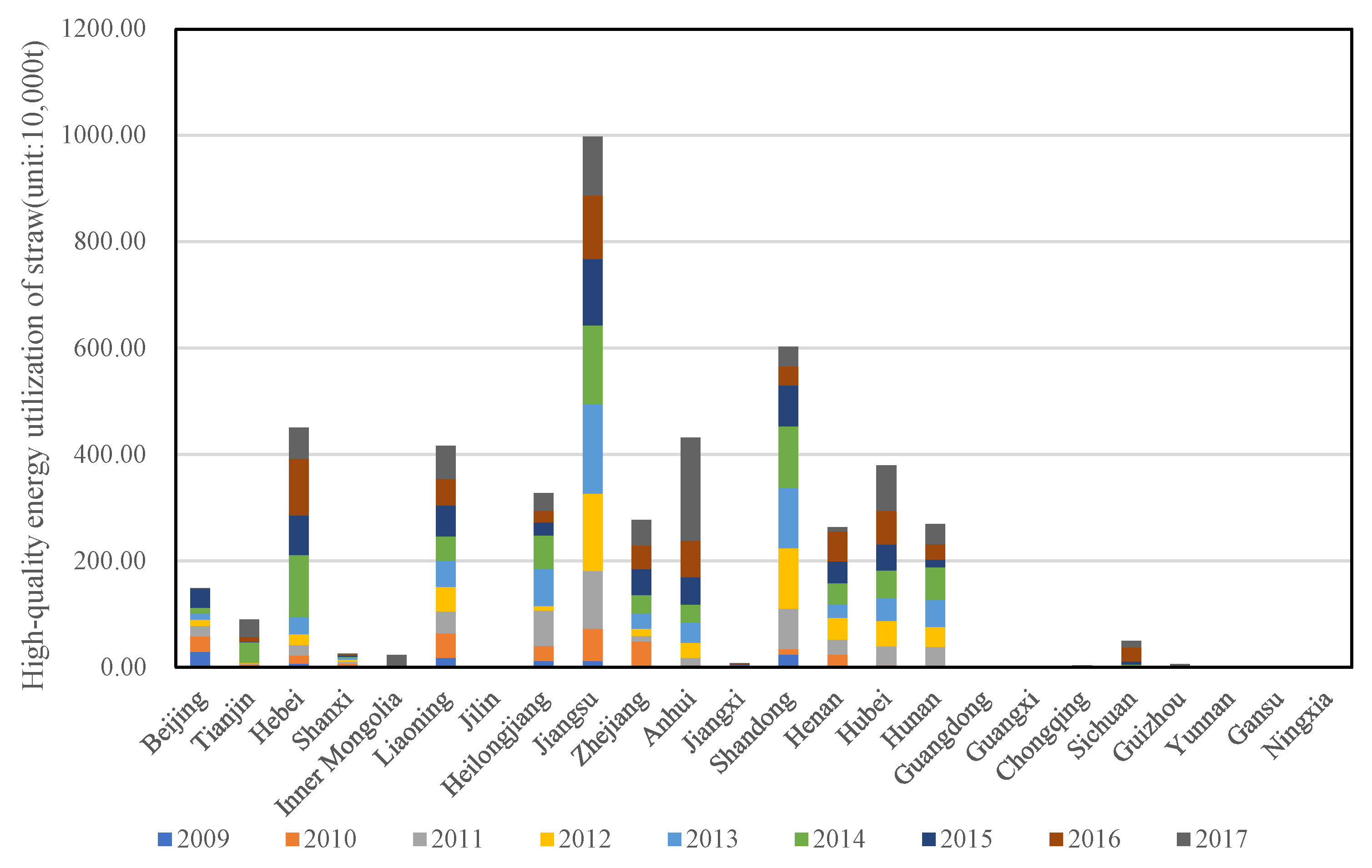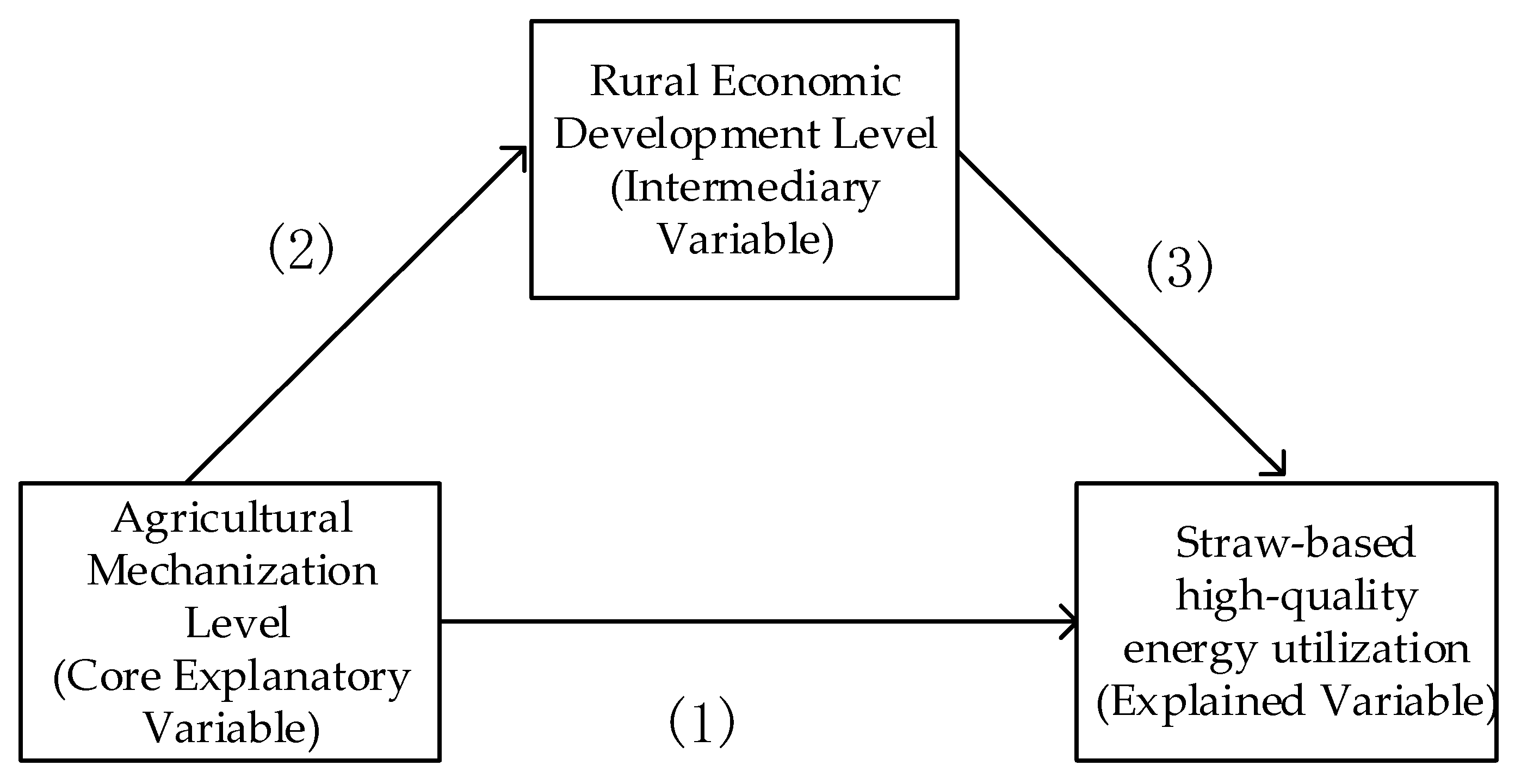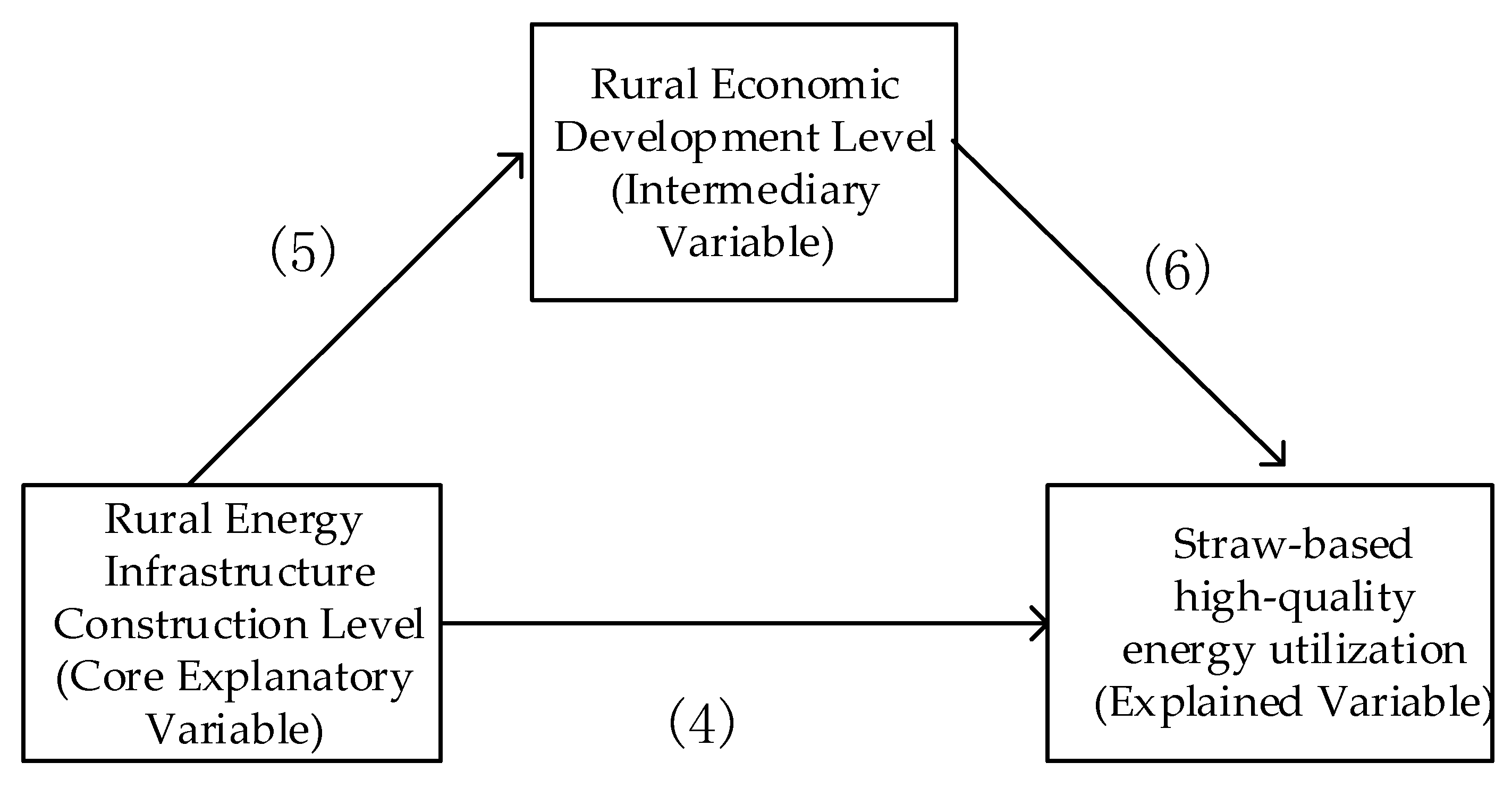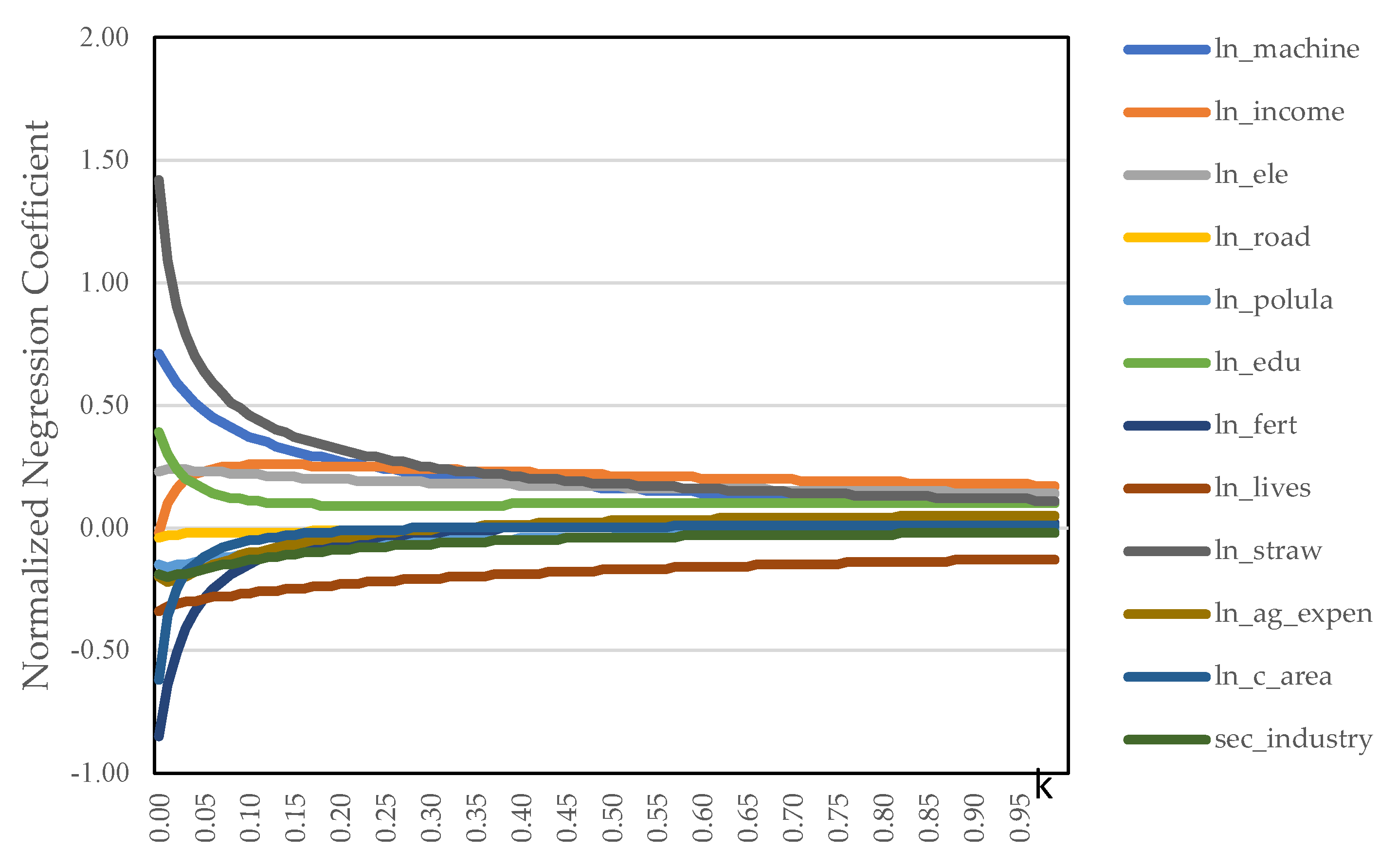Research on Straw-Based High-Quality Energy in China under the Background of Carbon Neutrality
Abstract
:1. Introduction
2. Materials and Methods
2.1. Variable Definitions
- 1.
- Explained variable: straw-based high-quality energy utilization.
- 2.
- Core explanatory variables: the agricultural mechanization level, and the rural energy infrastructure construction level.
- 3.
- Intermediate variable: rural economic development level.
- 4.
- Control variables.
2.2. Empirical and Econometric Steps
3. Results and Discussion
3.1. Descriptive Statistical Analysis
3.2. Colinear Diagnosis of Variables
3.3. Regression Analysis
3.4. Robustness Test
4. Conclusions and Policy Implications
Author Contributions
Funding
Institutional Review Board Statement
Informed Consent Statement
Data Availability Statement
Conflicts of Interest
References
- Sun, H.; Wang, E.; Li, X.; Cui, X.; Guo, J.; Dong, R. Potential biomethane production from crop residues in China: Contributions to carbon neutrality. Renew. Sustain. Energy Rev. 2021, 148, 111360. [Google Scholar] [CrossRef]
- Tawalbeh, M.; Rajangam, A.S.; Salameh, T.; Al-Othman, A.; Alkasrawi, M. Characterization of paper mill sludge as a renewable feedstock for sustainable hydrogen and biofuels production. Int. J. Hydrogen Energy 2021, 46, 4761–4775. [Google Scholar] [CrossRef]
- Ministry of Agriculture, PRC. China Agricultural Statistics 2016; China Agriculture Press: Beijing, China, 2017; p. 185. [Google Scholar]
- Barros, M.V.; Salvador, R.; de Francisco, A.C.; Piekarski, C.M. Mapping of research lines on circular economy practices in agriculture: From waste to energy. Renew. Sustain. Energy Rev. 2020, 131, 109958. [Google Scholar] [CrossRef]
- The Ministry of Agriculture and Rural Affairs of the People’s Republic of China. The First Meeting of the 13th National Committee of the CPPCC No. 3304. 2018. Available online: http://www.moa.gov.cn/gk/tzgg_1/tz/201810/t20181019_6161171.htm (accessed on 5 January 2022).
- Ren, J.; Yu, P.; Xu, X. Straw Utilization in China—Status and Recommendations. Sustainability 2019, 11, 1762. [Google Scholar] [CrossRef] [Green Version]
- Phuong, P.H.; Nghiem, T.; Thao, P.M.; Pham, C.; Thi, T.; Thanh Dien, N. Impact of rice straw open burning on local air quality in the Mekong Delta of Vietnam. Atmos. Pollut. Res. 2021, 12, 101225. [Google Scholar] [CrossRef]
- Liu, T.; He, G.; Lau, A.K.H. Statistical evidence on the impact of agricultural straw burning on urban air quality in China. Sci. Total Environ. 2020, 711, 134–633. [Google Scholar] [CrossRef]
- Sun, M.; Xu, X.; Wang, C.; Bai, Y.; Fu, C.; Zhang, L.; Fu, R.; Wang, Y. Environmental burdens of the comprehensive utilization of straw: Wheat straw utilization from a life-cycle perspective. J. Clean. Prod. 2020, 259, 120702. [Google Scholar] [CrossRef]
- Zheng, H.; Wang, Y.; Feng, X.; Li, S.; Leong, Y.K.; Chang, J. Renewable biohydrogen production from straw biomass—Recent advances in pretreatment/hydrolysis technologies and future development. Int. J. Hydrogen Energy 2021, in press. [Google Scholar] [CrossRef]
- Liu, L.; Zhang, J.; Zhang, C.; Qiu, H. Will the expansion of the scale of operation help farmers to adopt environmentally friendly production behaviors—Taking the return of straw to the field as an example. Agric. Technol. Econ. 2017, 5, 17–26. [Google Scholar]
- Seglah, P.A.; Wang, Y.; Wang, H.; Bi, Y.; Zhou, K.; Wang, Y.; Wang, H.; Feng, X. Crop straw utilization and field burning in Northern region of Ghana. J. Clean. Prod. 2020, 261, 121–191. [Google Scholar] [CrossRef]
- Zeng, Y.; Zhang, J.; He, K. Effects of conformity tendencies on households’ willingness to adopt energy utilization of crop straw: Evidence from biogas in rural China. Renew. Energy 2019, 138, 573–584. [Google Scholar] [CrossRef]
- Hu, Y.; Li, B.; Zhang, Z.; Wang, J. Farm size and agricultural technology progress: Evidence from China. J. Rural Stud. 2019. [Google Scholar] [CrossRef]
- Li, F.; Feng, S.; Lu, H.; Qu, F.; Haese, M.D. How do non-farm employment and agricultural mechanization impact on large-scale farming? A spatial panel data analysis from Jiangsu Province, China. Land Use Policy 2021, 107, 105517. [Google Scholar] [CrossRef]
- Jian-gong, Z.; Ting-wu, Y.; Guo-lei, Y. The paradox between farmers willingness and their behaviors of straw-return-to-field practice from the perspective of family endowment and the analysis of the moderating effects of farmers’ ecological cognition. Res. Agric. Mod. 2020, 41, 999–1010. [Google Scholar]
- Jiang, M.; Hu, X.; Chunga, J.; Lin, Z.; Fei, R. Does the popularization of agricultural mechanization improve energy-environment performance in China’s agricultural sector? J. Clean. Prod. 2020, 276, 124210. [Google Scholar] [CrossRef]
- Jin, X.; Zuo, X.; Dong, X.; Dong, Y.; Ding, H. Analysis of the policy guarantee mechanism of rural infrastructure based on deep learning. Technol. Forecast. Soc. Chang. 2021, 166, 120605. [Google Scholar] [CrossRef]
- Xueyan, Z.; Huanhuan, C.; Yanyan, M.A.; Zhiyu, G.; Bing, X. Spatio-temporal variation and its influencing factors of rural energy poverty in China from 2000 to 2015. Geogr. Res. 2018, 37, 1115–1126. [Google Scholar]
- Reidsma, P.; Bakker, M.M.; Kanellopoulos, A.; Alam, S.J.; Paas, W.; Kros, J.; de Vries, W. Sustainable agricultural development in a rural area in the Netherlands? Assessing impacts of climate and socio-economic change at farm and landscape level. Agric. Syst. 2015, 141, 160–173. [Google Scholar] [CrossRef]
- Qi, W.; Kangning, X.; Bin, Y.; Xingju, Z.; Wei, R. Consumption Characteristics of Rural Energies in Karst Area and their Influencing Factors. Chin. J. Agric. Resour. Reg. Plan. 2019, 40, 146–157. [Google Scholar]
- Liang, Y. Analysis of influencing factors of rural energy consumption structure in mountainous areas of Southwest China—A case study of Zhaotong City, Yunnan Province. J. Geogr. 2012, 2, 221–229. [Google Scholar]
- Clausen, L.T.; Rudolph, D. Renewable energy for sustainable rural development: Synergies and mismatches. Energ Policy 2020, 138, 111289. [Google Scholar] [CrossRef]
- Xuelian, W.; Junbiao, Z.; Junhui, F. Farmers’ willingness to participate in the market circulation of crop straws and its influence factors. Arid Area Resour. Environ. 2017, 31, 79–84. [Google Scholar]
- Fang, J.; Wang, X.; Wen, Z.; Huang, J. Cybervictimization and loneliness among Chinese college students: A moderated mediation model of rumination and online social support. Child Youth Serv. Rev. 2020, 115, 105085. [Google Scholar] [CrossRef]
- Phiri, J.; Malec, K.; Kapuka, A. Impact of Agriculture and Energy on CO2 Emissions in Zambia. Energies 2021, 14, 8339. [Google Scholar] [CrossRef]
- Li, G.; Li, Y.; Zhou, X. Agricultural Mechanization, Labor Transfer and the Growth of Farmer’s Income: A Re-examination of Causality. China’s Rural Econ. 2018, 11, 112–127. [Google Scholar]
- Gai, H.; Yan, T.; Zhang, J. Perceived Value, Government Regulations and Farmers’Behaviors of Continued Mechanized Operation of Straw Returning to the Field:An Analysis Based on Survey Data from 1288 Farmers in Three Provinces of Hebei, Anhui and Hubei. China’s Rural Econ. 2020, 8, 106–123. [Google Scholar]
- Hoerl, A.E.; Kennard, R.W. Ridge regression: Biased estimation for nonorthogonal problems. Technometrics 1970, 1, 55–67. [Google Scholar] [CrossRef]
- Hoerl, A.E.; Kannard, R.W.; Baldwin, K.F. Ridge regression: Some simulations. Theory Methods 1975, 2, 105–123. [Google Scholar] [CrossRef]
- Yrjälä, K.; Ramakrishnan, M.; Salo, E. Agricultural waste streams as resource in circular economy for biochar production towards carbon neutrality. Curr. Opin. Environ. Sci. Health 2022, 100339. [Google Scholar] [CrossRef]




| Variable Types | Variable Name | Variable Code | Variable Declaration |
|---|---|---|---|
| Explained Variable | Straw-based high-quality energy utilization | Utilize | t, high-quality energy utilization of crop straw |
| Core Explanatory Variables | Rural mechanization level | machine | 10,000 kW, expressed by the total power of agricultural machinery, mainly including agricultural tractors, combine harvesters, motorized threshers and other machinery |
| Rural energy infrastructure construction level | ele | 100 million kW·h, expressed in rural electricity consumption | |
| Mediating Variable | Income level of rural residents | income | Yuan/person, per capita disposable income of rural households |
| Control Variable | Rural population | popula | 10,000, rural population |
| Financial education expenditure | edu | 100 million yuan, local fiscal expenditure-education expenditure | |
| Fiscal expenditure on agricultural support | ag_expen | 100 million yuan, local fiscal expenditure-expenditure on agriculture, forestry and water affairs | |
| Urban-rural income gap | income_gap | Per capita disposable income of urban households/per capita disposable income of rural households | |
| Amount of agricultural fertilizer | fert | 10,000 t, the amount of chemical fertilizers actually used in agricultural production this year, calculated by the discount method | |
| Total sown area of crops | c_area | 1000 hm2, total sown area of crops | |
| Number of large livestock stocks at the end of the year | lives | 10,000, large livestock, pigs, sheep, poultry and other livestock and poultry number | |
| Straw yield | straw | 10,000 t, calculated by the method of “grass-valley ratio” |
| Project | Centralized Gas Supply by Pyrolysis and Gasification of Straw | Straw Methane Centralized Gas Supply | Straw Curing Molding Fuel | Straw Carbonization |
|---|---|---|---|---|
| Convert Standard | Air gasification: 1 kg straw gasification gas is 2 m3, and each household needs 3 m3 of gas every day | Medium temperature fermentation, straw gas production rate 35%, biogas proportion 0.97 kg/m3, the average household needs to use 1 m3 per day | 1.1 t straw to produce molding fuel 1 t | 1 t straw to produce 0.3 t biochar |
| Variable | Observations | Mean | Median | Std. Dev. | Minimum | Maximum |
|---|---|---|---|---|---|---|
| ln utiliz | 216 | 10.02 | 10.08 | 2.813 | 3.466 | 14.47 |
| ln machine | 216 | 7.930 | 8.025 | 0.912 | 4.894 | 9.499 |
| ln income | 216 | 9.086 | 9.118 | 0.438 | 8.000 | 10.13 |
| ln ele | 216 | 4.903 | 4.580 | 1.182 | 2.313 | 7.543 |
| ln popula | 216 | 7.514 | 7.712 | 0.823 | 5.565 | 8.684 |
| ln edu | 216 | 6.393 | 6.410 | 0.637 | 4.151 | 7.854 |
| ln fert | 216 | 5.062 | 5.415 | 0.925 | 2.140 | 6.574 |
| ln lives | 216 | 5.513 | 6.082 | 1.222 | 2.587 | 7.010 |
| ln ag expen | 216 | 5.977 | 6.058 | 0.569 | 4.154 | 6.931 |
| ln c area | 216 | 8.445 | 8.685 | 0.982 | 4.795 | 9.609 |
| ln straw | 216 | 7.776 | 8.016 | 1.059 | 4.224 | 9.312 |
| income gap | 216 | 2.759 | 2.644 | 0.507 | 1.845 | 4.281 |
| Variable | VIF | 1/VIF |
|---|---|---|
| ln c_area | 42.50 | 0.0235 |
| ln straw | 33.34 | 0.0300 |
| ln income | 29.87 | 0.0335 |
| ln fert | 22.79 | 0.0439 |
| ln popula | 20.84 | 0.0480 |
| ln edu | 16.61 | 0.0602 |
| ln ag_expen | 14.56 | 0.0687 |
| Income_gap | 9.370 | 0.107 |
| ln ele | 4.620 | 0.216 |
| ln lives | 4.250 | 0.235 |
| Mean VIF | 19.87 |
| Test Type | Testing Purpose | Test Value | Test Results |
|---|---|---|---|
| F Test | FE Model or POOL Model? | F (23,181) = 11.706, p = 0.000 | FE Model |
| BP Test | FE Model or POOL Model? | χ2(1) = 188.242, p = 0.000 | RE Model |
| Hausman Test | FE Model or RE Model? | χ2(11) = 21.471, p = 0.029 | FE Model |
| Variable | Model 1 | Model 2 | Model 3 | Model 4 | Model 5 | Model 6 |
|---|---|---|---|---|---|---|
| ln_income | 0.679 *** | 0.651 *** | ||||
| 6.06 | 6.830 | |||||
| ln_machine | 0.186 *** | 0.00962 ** | 0.179 *** | |||
| 2.990 | 2.140 | 2.89 | ||||
| ln_ele | 0.0492 *** | 0.0267 *** | 0.0318 *** | |||
| 2.72 | 17.17 | 1.830 | ||||
| ln_popula | −0.0893 *** | −0.0277 *** | −0.0705 *** | −0.0728 *** | −0.0238 *** | −0.0573 *** |
| −4.740 | −20.27 | −4.030 | −5.460 | −20.71 | −4.700 | |
| ln_edu | 0.664 *** | 0.242 *** | 0.499 *** | 0.582 *** | 0.221 *** | 0.438 *** |
| 7.210 | 36.29 | 5.96 | 7.7 | 33.85 | 6.740 | |
| ln_fert | 0.0621 ** | 0.00587 *** | 0.0582*** | 0.0500 ** | 0.00565 *** | 0.0464 *** |
| 2.210 | 2.890 | 2.07 | 2.51 | 3.290 | 2.330 | |
| ln_lives | 0.0333 | −0.0138 *** | 0.0427 | 0.0197 | −0.0111 *** | 0.0269 |
| 1.100 | −6.310 | 1.43 | 0.950 | −6.160 | 1.310 | |
| ln_ag_expen | 0.618 *** | 0.325 *** | 0.397 *** | 0.580 *** | 0.292 *** | 0.389 *** |
| 5.310 | 38.53 | 3.980 | 5.990 | 35.01 | 4.890 | |
| ln_c_area | 0.136 *** | −0.00183 | 0.137 *** | 0.0964 *** | −0.00105 | 0.0971 *** |
| 4.480 | −0.830 | 4.530 | 4.440 | −0.560 | 4.480 | |
| income_gap | −0.502 *** | −0.246 *** | −0.335 *** | −0.477 *** | −0.220 *** | −0.334 *** |
| −3.280 | −22.13 | −2.300 | −4.020 | −21.53 | −3.010 | |
| ln_straw | 0.153 *** | 0.0158 *** | 0.142 *** | 0.114 *** | 0.0135 *** | 0.105 *** |
| 4.060 | 5.780 | 3.800 | 4.290 | 5.870 | 4.000 | |
| R2 | 0.9885 | 0.9657 | 0.9886 | 0.9882 | 0.9502 | 0.9883 |
| Adj-R2 | 0.9865 | 0.9597 | 0.9865 | 0.9816 | 0.9415 | 0.9862 |
| F | 11.1791 | 300.2139 | 10.1201 | 10.9178 | 207.0911 | 9.9763 |
| Variable | Model 1 | Model 2 | Model 3 | Model 4 | Model 5 | Model 6 |
|---|---|---|---|---|---|---|
| ln_consum | 0.457 *** | 0.471 *** | ||||
| 3.970 | 5 | |||||
| ln_machine | 0.186 *** | 0.00737 * | 0.184 *** | |||
| 2.990 | 1.86 | 2.950 | ||||
| ln_ele | 0.0492 *** | 0.0316 *** | 0.0343 ** | |||
| 2.72 | 15.04 | 1.970 | ||||
| ln_popula | −0.0893 *** | −0.0233 *** | −0.0739 *** | −0.0728 *** | −0.0286 *** | −0.0594 *** |
| −4.740 | −18.52 | −4.250 | −5.460 | −18.43 | −4.890 | |
| ln_edu | 0.664 *** | 0.226 *** | 0.531 *** | 0.582 *** | 0.262 *** | 0.458 *** |
| 7.210 | 26.38 | 6.340 | 7.7 | 29.84 | 7.070 | |
| ln_fert | 0.0621 ** | 0.00399 ** | 0.0609 ** | 0.0500 ** | 0.00353 | 0.0484 ** |
| 2.210 | 2.28 | 2.160 | 2.51 | 1.520 | 2.420 | |
| ln_lives | 0.0333 | −0.0100 *** | 0.0406 | 0.0197 | −0.0130 *** | 0.0258 |
| 1.100 | −5.480 | 1.350 | 0.950 | −5.350 | 1.250 | |
| ln_ag_expen | 0.618 *** | 0.295 *** | 0.440 *** | 0.580 *** | 0.346 *** | 0.416 *** |
| 5.310 | 26.84 | 4.370 | 5.990 | 30.79 | 5.210 | |
| ln_c_area | 0.136 *** | −0.000689 | 0.136 *** | 0.0964 *** | −0.001 | 0.0969 *** |
| 4.480 | −0.360 | 4.490 | 4.440 | −0.410 | 4.450 | |
| income_gap | −0.502 *** | 0.0118 *** | 0.145 *** | −0.477 *** | 0.0146 *** | 0.107 *** |
| −3.280 | 5.01 | 3.860 | −4.020 | 4.720 | 4.050 | |
| ln_straw | 0.153 *** | −0.196 *** | −0.392 *** | 0.114 *** | −0.222 *** | −0.373 *** |
| 4.060 | −16.31 | −2.570 | 4.290 | −16.07 | −3.220 | |
| R2 | 0.9885 | 0.9997 | 0.9885 | 0.9882 | 0.9310 | 0.9882 |
| Adj-R2 | 0.9865 | 0.9996 | 0.9864 | 0.9816 | 0.9189 | 0.9861 |
| F | 11.1791 | 98.9215 | 10.3166 | 10.9178 | 151.6225 | 10.0881 |
Publisher’s Note: MDPI stays neutral with regard to jurisdictional claims in published maps and institutional affiliations. |
© 2022 by the authors. Licensee MDPI, Basel, Switzerland. This article is an open access article distributed under the terms and conditions of the Creative Commons Attribution (CC BY) license (https://creativecommons.org/licenses/by/4.0/).
Share and Cite
Ren, J.-Q.; Yang, Y.-W.; Chi, Y.-Y. Research on Straw-Based High-Quality Energy in China under the Background of Carbon Neutrality. Energies 2022, 15, 1724. https://doi.org/10.3390/en15051724
Ren J-Q, Yang Y-W, Chi Y-Y. Research on Straw-Based High-Quality Energy in China under the Background of Carbon Neutrality. Energies. 2022; 15(5):1724. https://doi.org/10.3390/en15051724
Chicago/Turabian StyleRen, Ji-Qin, Ya-Wen Yang, and Yuan-Ying Chi. 2022. "Research on Straw-Based High-Quality Energy in China under the Background of Carbon Neutrality" Energies 15, no. 5: 1724. https://doi.org/10.3390/en15051724
APA StyleRen, J.-Q., Yang, Y.-W., & Chi, Y.-Y. (2022). Research on Straw-Based High-Quality Energy in China under the Background of Carbon Neutrality. Energies, 15(5), 1724. https://doi.org/10.3390/en15051724





